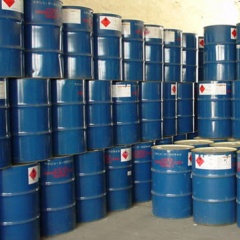Ethylenedichloride
| Infobox on Ethylenedichloride | |
|---|---|
| Example of Ethylenedichloride |  |
| Facts | |
| Origin | - |
| Stowage factor (in m3/t) | - |
| Humidity / moisture | - |
| Ventilation | See text |
| Risk factors | See text |
Ethylenedichloride
Description / Application
The chemical compound 1,2-dichloroethane, commonly known by its old name of ethylene dichloride (EDC), is a chlorinated hydrocarbon, mainly used to produce vinyl chloride monomer (VCM, chloroethene), the major precursor for PVC production. It is a colourless liquid with a chloroform-like odour. 1,2-Dichloroethane is also used generally as an intermediate for other organic chemical compounds and as a solvent. It forms azeotropes with many other solvents, including water and other chlorocarbons.
Use; production of vinyl chloride, trichloroethylene, vinylidene chloride, and trichloroethane; lead scavenger in antiknock gasoline; paint, varnish, and finish removers; metal degreasing, soaps and scouring compounds, wetting and penetrating agents, organic synthesis, ore flotation, solvent, fumigant.
Shipment / Storage
Fire and explosion hazards: Moderate fire hazard. Vapor/air mixtures are explosive. The vapor is heavier than air. Vapors or gases may ignite at distant ignition sources and flash back.
Store and handle in accordance with all current regulations and standards. Keep container tightly closed and properly labeled. Store in a cool, dry place. Store in a well-ventilated area. Do not enter confined spaces without following proper confined space entry procedures. Do not store in aluminum container or use aluminum fittings or transfer lines. Avoid heat, flames, sparks and other sources of ignition. Keep separated from incompatible cargo.
| Melting point | -35°C. | |
| Boiling point | 84°C. | |
| Freezing point | -35°C. | |
| Density | 1,253 g/cm3, liquid | |
| Flashpoint | 13°C. | |
| Lower flammable limit | 6.2% | |
| Upper flammable limit | 15.9% | |
| Autoignition | 413°C. | - |
Risk factors
Toxic by ingestion, inhalation and skin absorption; strong irritant to eyes and skin, a carcinogen. Flammable, dangerous fire risk, explosive limits in air 6-16%. TLV: 10 ppm in air.
For overseas carriage aspects of Chemicals, the readers are recommended to acquire or have access to a good chemical dictionary, and a copy of the International Maritime Dangerous Goods (IMDG) Code, issued by the International Maritime Organisation. Also consult the applicable MSDS sheet.
Environmentally hazardous substance.
See also: http://www.chemicalland21.com/industrialchem/organic/ETHYLENE%20DICHLORIDE.htm











